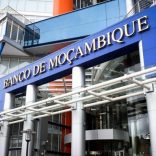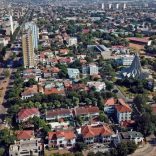Mozambique: President Chapo calls for air links between African countries
Mozambique: Central Bank cuts benchmark interest rate

Photo: TVM
The Bank of Mozambique on Monday cut its benchmark interest rate by 75 base points.
A statement from the Bank’s Monetary Policy Committee (CPMO), said that the Interbank Money Market Rate (MIMO), falls from 16.5 to15.75 per cent, with immediate effect. The central bank’s interventions on the interbank money market to regulate liquidity are based on this rate.
The Standing Lending Facility (the interest rate paid by the commercial banks to the central bank for money borrowed on the Interbank Money Market) remains unchanged at 18 per cent, while the Standing Deposit Facility (the rate paid by the central bank to the commercial banks on money they deposit with it) is cut by 50 base points from 12.5 to 12 per cent.
The Compulsory Reserves Coefficient – the amount of money that the commercial banks must deposit with the Bank of Mozambique –also remains unchanged at 14 per cent for local currency, and at 22 per cent for foreign currency.
Speaking at a Maputo press conference, the governor of the Bank of Mozambique, Rogerio Zandamela, said the economic conditions “continue to favour the forecast of low and stable inflation, in the medium term, but there remain various risks which require prudence in the conduct of monetary policy”.
He pointed to “the risk associated with the sustainability of the public debt, and the uncertainties about the development of administered prices” (a reference mainly to fuel prices).
There were also international risks “associated with the commercial tension between the main economies” (a reference to the trade war declared by US President Donald Trump), as well as the volatility of the US dollar and of key commodity prices (notably oil).
Nonetheless, the central bank believed a further relaxation in its benchmark interest rate was in order.
This year the Bank of Mozambique has repeatedly cut the MIMO rate – but has not elicited the response it had wanted from the commercial banks, whose interest rates remain extortionate.
The commercial banks “are reacting timidly to the fall in the MIMO rate”, was how Zandamela delicately put it. The average retail interest rate for loans of a year fell by only 3.2 per cent between December and April, when they were 28.69 per cent. The prime rate in the banking system has fallen from 27.25 per cent at the end of 2017 to 22.5 per cent now.
A consequence of these high interest rates is that many businesses are not borrowing from Mozambican banks. “Bank credit to the private sector remains stagnant”, said Zandamela.
The figures on inflation, published by the National Statistics Institute (INE), and based on the consumer price indices of the three largest cities (Maputo, Nampula and Beira), are encouraging. Zandamela noted that annual inflation from June 2017 to May 2018 was 3.26 per cent – which compares with 20.45 per cent in the previous year.
The Mozambican currency, the metical, has also made gains against both the US dollar and the South African rand. From 10 April (the day before the previous meeting of the CPMO) to 15 June, the average exchange rate in the commercial banks rose from 60.98 to 59.38 meticais to the dollar.
There was a far sharper appreciation against the rand, the currency in which many of Mozambique’s imports, particularly of food and drink, are denominated. There were 5.05 meticais to the rand on 10 April, and by 1 June this had improved to 4.49 meticais to the rand.
As for the country’s net international reserves, Zandamela said the central bank had been able to make net purchases of foreign currency from the banking system, and the country’s reserves now stood at 3.235 billion dollars, enough to cover seven months of imports of goods and non-factor services, excluding the transactions of the foreign investment mega-projects.
Economic growth, however, has remained sluggish. Zandamela said that data on the Gross Domestic Product referring to the first quarter of the year indicate an annual growth rate of 3.2 per cent, a significant decline on the 4.5 per cent observed in the first quarter of 2017.
The public deficit increased in the first quarter, and was covered by foreign grants and loans for investment projects (but not for general budget support, which remains suspended). 46 per cent of the deficit was covered by domestic indebtedness of 4.343 billion meticais (about 73 million dollars).
Zandamela pointed out that by May the total domestic public debt contracted in the form of high interest bearing treasury bonds and bills had reached 105.557 billion meticais – an increase of 9.975 billion meticais since the start of the year.
Mozambican exports are now dominated by coal and aluminium. Between the first quarter of 2017 and the same period in 2018, coal exports rose in value from 344 to 370 million dollars. Exports of aluminium ingots from the MOZAL smelter on the outskirts of Maputo rose from 248 to 311 million dollars.
The balance of trade improved sharply, since total January-March exports were 194 million dollars, while total imports were 82 million dollars.












Leave a Reply
Be the First to Comment!
You must be logged in to post a comment.
You must be logged in to post a comment.